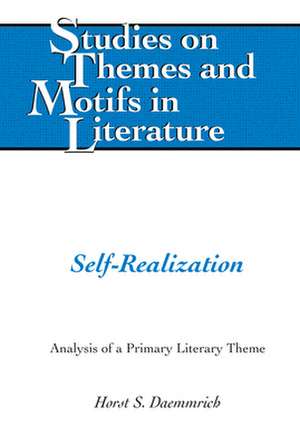Self-Realization: Studies on Themes and Motifs in Literature
Autor Horst Daemmrichen Limba Engleză Hardback – 28 sep 2021
The study of self-realization as a primary literary theme covers a wide range of literature. The journey to self-discovery can be represented in many different forms, from novels of development to social criticism and to historical plays. It can provide the core of a basic literary form, such as a fairytale and the decision on crossroads of life. The self as a primary literary element can be identified as an axis of symmetry, similar to a central section of a wheel, which connects to all related themes. The description of space, setting, time, historical moment, and heritage shape all documentation of self-orientation. Thematic developments highlight specific appropriate locations for the unfolding story. By comparing works from different periods and examining manifestations of the theme in American, French, English, and German literature, this study traces the theme of self-realization in the coming-of-age constellation, the acceptance and the criticism of existing social conditions, the attempts to comprehend the past and the current historical conditions, and in utopian visions of the future.
While literature has provided singular and unforgettable portraits of figures in works ranging from Bellow, Dickens, Fontane, Goethe, Moliere, Schiller, Grass, and Raabe to Tolstoy or Trollope, it is equally apparent that primary forms of self-realization show a high correlation of recurring patterns. Some features associated with primary thematic emphasis and resolution occur with high frequency. Figures can be conceived of as being capable of intellectual and spiritual growth. Alternately, in a moment of insight, they may persevere in their errors in judgment, the frailty of institutions, or a web of circumstances that impeded their optimal development. In such instances, the action is usually designed to convey a vision of human potential to the reader--and furthermore, raise serious questions about the apparent predetermination of existence.
Din seria Studies on Themes and Motifs in Literature
- 23%
 Preț: 617.77 lei
Preț: 617.77 lei - 23%
 Preț: 639.26 lei
Preț: 639.26 lei - 23%
 Preț: 639.71 lei
Preț: 639.71 lei - 23%
 Preț: 622.37 lei
Preț: 622.37 lei - 8%
 Preț: 519.07 lei
Preț: 519.07 lei - 23%
 Preț: 521.04 lei
Preț: 521.04 lei - 23%
 Preț: 635.44 lei
Preț: 635.44 lei - 23%
 Preț: 639.12 lei
Preț: 639.12 lei - 23%
 Preț: 559.52 lei
Preț: 559.52 lei - 23%
 Preț: 618.36 lei
Preț: 618.36 lei - 23%
 Preț: 674.29 lei
Preț: 674.29 lei - 23%
 Preț: 724.50 lei
Preț: 724.50 lei - 23%
 Preț: 572.21 lei
Preț: 572.21 lei - 23%
 Preț: 612.33 lei
Preț: 612.33 lei - 23%
 Preț: 696.19 lei
Preț: 696.19 lei - 23%
 Preț: 705.26 lei
Preț: 705.26 lei - 23%
 Preț: 642.23 lei
Preț: 642.23 lei - 23%
 Preț: 693.84 lei
Preț: 693.84 lei - 23%
 Preț: 576.36 lei
Preț: 576.36 lei - 23%
 Preț: 550.86 lei
Preț: 550.86 lei - 19%
 Preț: 609.11 lei
Preț: 609.11 lei - 23%
 Preț: 537.39 lei
Preț: 537.39 lei - 23%
 Preț: 511.10 lei
Preț: 511.10 lei - 23%
 Preț: 574.30 lei
Preț: 574.30 lei - 8%
 Preț: 487.77 lei
Preț: 487.77 lei - 23%
 Preț: 545.09 lei
Preț: 545.09 lei - 23%
 Preț: 665.50 lei
Preț: 665.50 lei - 23%
 Preț: 579.64 lei
Preț: 579.64 lei -
 Preț: 361.86 lei
Preț: 361.86 lei - 23%
 Preț: 628.01 lei
Preț: 628.01 lei - 23%
 Preț: 662.99 lei
Preț: 662.99 lei - 23%
 Preț: 682.88 lei
Preț: 682.88 lei - 23%
 Preț: 548.51 lei
Preț: 548.51 lei - 23%
 Preț: 620.71 lei
Preț: 620.71 lei - 23%
 Preț: 506.95 lei
Preț: 506.95 lei - 23%
 Preț: 655.88 lei
Preț: 655.88 lei - 8%
 Preț: 514.88 lei
Preț: 514.88 lei - 27%
 Preț: 722.48 lei
Preț: 722.48 lei - 23%
 Preț: 607.52 lei
Preț: 607.52 lei -
 Preț: 516.00 lei
Preț: 516.00 lei - 7%
 Preț: 187.78 lei
Preț: 187.78 lei - 6%
 Preț: 192.03 lei
Preț: 192.03 lei - 7%
 Preț: 194.80 lei
Preț: 194.80 lei - 20%
 Preț: 332.25 lei
Preț: 332.25 lei - 20%
 Preț: 340.89 lei
Preț: 340.89 lei - 20%
 Preț: 460.33 lei
Preț: 460.33 lei -
 Preț: 365.76 lei
Preț: 365.76 lei - 21%
 Preț: 330.24 lei
Preț: 330.24 lei
Preț: 574.25 lei
Preț vechi: 745.77 lei
-23% Nou
109.88€ • 115.02$ • 91.46£
Carte tipărită la comandă
Livrare economică 31 martie-14 aprilie
Specificații
ISBN-10: 1433187256
Pagini: 194
Dimensiuni: 150 x 225 mm
Greutate: 0.45 kg
Editura: Peter Lang Copyright AG
Seria Studies on Themes and Motifs in Literature
Notă biografică
Cuprins
Introduction - Figures at Cross- Roads - Self- Realization: Coming- of- Age. Search for Orientation. Experience of Reality. Journey - Integration: Controlling Destiny by Accepting Existing Social Conditions - Isolation: The Shattered Self - Criticism of Society - Figures Probing the Current Historical Situation: Understanding the Past. Blindness and Self- Insight- Self- Realization and Vision of the Future - Conclusion: Self As Axis - Bibliography - Author Index - Index of Examined Works.
